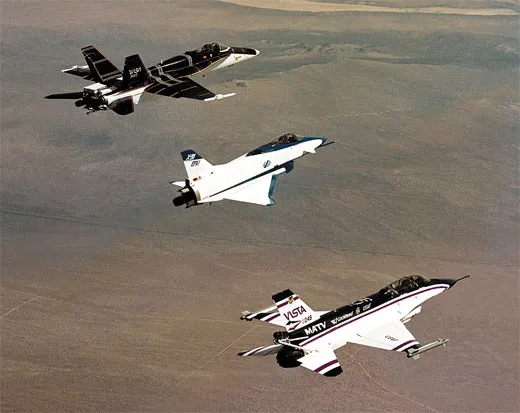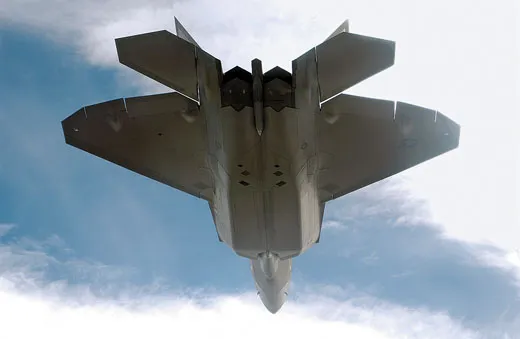How Things Work: Thrust Vectoring
In a tight spot, you need zoom to maneuver.
/https://tf-cmsv2-smithsonianmag-media.s3.amazonaws.com/filer/thrust-vector-631.jpg)
Remember the scene in the movie Top Gun when Navy pilot Pete “Maverick” Mitchell gets the upper hand on his instructors by slowing down, pulling up the nose of his F-14 Tomcat, and watching his opponent fly right by? The idea was to get a quick, unexpected position behind the bad guy, putting Maverick (played by Tom Cruise) and his trusty sidekick Goose into place to win the Engagement.
Real fighter pilots will tell you that what Maverick does is a showoff move that bleeds off so much energy that you’re vulnerable to getting shot down yourself. What a pilot really needs is a way to quickly get in the right position to fire at the enemy. Today’s most maneuverable fighters use thrust vectoring, which can make a jet turn faster and more tightly.
Powered by Pratt & Whitney F119 turbofans, each with 35,000 pounds of thrust, the F-22A—the Air Force’s newest fighter—sports a nozzle that can direct exhaust thrust up or down as much as 24 degrees.
The advantage to pilots is superior low-speed and high angle-of-attack maneuverability, compared to conventional-thrust aircraft, says Second Lieutenant Aaron Hoke, a propulsion engineer on the U.S. Air Force team that manages the Lockheed Martin F-22A Raptor program at Wright-Patterson Air Force Base in Ohio.
“Our [one-on-one] tactics have changed to incorporate the ‘post-stall’ regime, where other aircraft cannot operate,” explains Captain John “Rocks” Wagemann, who flies the F-22A in the First Fighter Wing at Langley Air Force Base in Virginia. Thrust vectoring enables the pilots to fly up and over in a very tight arc, Wagemann says, and “gives us the nose authority to turn the jet while the wings are stalled, similar to a controlled flat spin.”
Thanks to advanced computers and flight control systems, pilots don’t have to think about choosing vectoring or executing specific steps to perform a maneuver. They simply point the airplane where they want, and the onboard systems automatically coordinate the right combination of flaps, rudder, elevator, and nozzle angle. “The F119’s vectoring nozzle is integrated into the F-22 flight control system” so that “the pilot doesn’t control the nozzle independently,” says Chris Flynn, Pratt & Whitney’s F119 director.
Flaps in the engine nozzle point up or down to “steer” the jet exhaust, making the airplane more responsive and maneuverable. In a two-engine airplane like the F-22, directing the exhaust from both engines upward points the nose up, while reversing the direction points the nose down. The F119 engines are designed to vector in the same direction and by the same amount. The nozzle is said to be “two dimensional” when the shape of the throat is rectangular.
Flight tests of thrust-vectoring designs began in the early 1990s with airplanes like NASA’s modified F/A-18 and F-15, the Rockwell/MBB X-31, and a modified Air Force F-16. In 1994, the X-31 demonstrator was fitted with what German program managers called a “poor man’s thrust vectoring nozzle”—three paddle-like vanes that pushed into the exhaust stream—and the results were spectacular. Without thrust vectoring, the X-31 lost twice as often as it won against the F/A-18 in mock combat; with it, the X-31 didn’t lose once in 129 matches.
Theorists say air combat could be changed by the introduction of some maneuvers unique to thrust vectoring. A high angle-of-attack descending spiral is one. At a high angle of attack, a rudder loses its effectiveness, and being able to rely on thrust vectoring would let a pilot enter what’s essentially a controlled flat spin, yawing the airplane around to aim at a target without worrying about the rudder. The pilot also gets extra maneuverability at high altitudes, says Wagemann, “where the air density is so low that the flight control surfaces become significantly degraded.” Then there’s the super-tight J-turn, or even a modified hammerhead, in which an airplane appears to briefly fly backward.
One common misconception about thrust vectoring involves the flashy cobra maneuver, also known as Pugachev’s cobra, after Russian pilot Viktor Pugachev, who first wowed crowds with it in a Sukhoi Su-27 at the 1989 Paris Air Show. The maneuver is not an example of thrust vectoring. If the pilot is skilled enough, he can do the cobra in nearly any type of U.S. jet fighter. In essence, the pilot abruptly pulls the control yoke full aft while flying around 300 knots—about 345 mph—and thus pitches the nose up dramatically so the airplane is nearly standing on its tail. Just as abruptly, the pilot pushes the stick forward, dropping the nose back down. When the maneuver is flown correctly, with little change in altitude, the effect is like the striking of a cobra’s head.
Right now, the F-22A and the Russian Sukhoi Su-37 and Su-30MKI (flying with the Indian air force) are the only fighter aircraft with two-dimensional thrust vectoring nozzles.
More sophisticated designs, which have yet to fly beyond the testing stage, feature nozzle flaps that can move 17 to 20 degrees in nearly any direction, resulting in maneuvers around both the pitch and yaw axes. Both major U.S. fighter engine makers, Pratt & Whitney and General Electric, tested multi-axis vectored nozzles about a decade ago for an Air Force demonstration program.
Until thrust vectoring becomes more widespread, few will enjoy that extra edge—and that’s just fine with U.S. pilots. “Thrust vectoring provides such a significant advantage in the visual maneuvering arena that I rarely find myself in a defensive position,” says Wagemann. “When we start defensive, for training, you are almost always able to transition to offensive without getting shot.”

